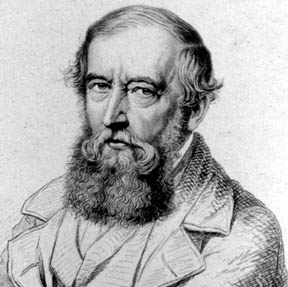
| Among the well known objects in triangle geometry are the Steiner point and Steiner ellipse, named in honor of Jakob Steiner. The latter is the ellipse that passes through the three vertices of a triangle ABC and has the centroid of ABC as its center. This ellipse has not only the points A,B,C in common with the circumcircle of triangle ABC, but also a fourth point, namely, the Steiner point. The classical construction of the Steiner point (link below), however, does not depend on the Steiner ellipse. |

|
Steiner was one of the greatest of all geometers. Born to a farm family near Bern, Switzerland, at first his opportunities for education were meager. It is said that he first learned to write at the age of fourteen. However, within the next four years, his mathematical powers had been recognized, and he was permitted to attend the famous innovative school of Johann Heinrich Pestalozzi in Yverdon, Switzerland. Before reaching the age of twenty, he was teaching mathematics at the school.
In 1818, Steiner moved to Heidelberg, Germany, where he gave private instruction in mathematics. Three years later, he moved to Berlin and continued teaching. There he became acquainted with N. H. Abel (as in abelian groups), A. L. Crelle (who in 1826 started the still running Journal für reine und angewandte Mathematik), and C. G. J. Jacobi (as in Jacobians).
| It was through Jacobi's efforts, while a professor at the University of Königsberg, that this university conferred on Steiner an honorary Ph.D. Under the influence of Jacobi and the brothers Alexander and William von Humboldt, a chair of geometry was established for Steiner at the University of Berlin, and Steiner was elected a fellow of the Prussian Academy of Sciences. Steiner remained at the University of Berlin until his last years, which he spent in his native Switzerland. |

|
For an account in English of Steiner's life and publications, as well as a translation of one of his major works, see
Marion Elizabeth Stark and Raymond Clare Archibald, Jacob Steiner's Geometrical Constructions with a Ruler, Given a Fixed Circle with Its Center, Scripta Mathematica, Yeshiva University, New York, 1970.
Steiner's collected works were edited by Karl Weierstrass:
Jakob Steiner, Gesammelte Werke, 2 volumes, Prussian Academy of Sciences, Berlin, 1881-1882. Reprinted, 1971, Chelsea, New York.
The following topics are described in the CRC Concise Encyclopedia of Mathematics (Eric W. Weisstein, 1999):
Steiner Chain, Steiner Construction, Steiner's Ellipse, Steiner's Hypocycloid (i.e., the Deltoid), Steiner-Lehmus Theorem, Steiner Points (in addition to the Steiner point already mentioned), Steiner's Porism, Steiner's Problem, Steiner Quadrulple System, Steiner's Segment Problem, Steiner Set, Steiner Surface, Steiner System, Steiner's Theorem, Steiner Triple System, and Poncelet-Steiner Porism.
In addition to these, the Encyclopedic Dictionary of Mathematics (2nd edition, Mathematical Society of Japan, MIT Press, 1993) includes Steiner's method of symmetrization as a powerful means of discovering isoperimetric inequalities (column 228 B). Under the heading Geometric Construction (column 179), this Dictionary lists four famous famous construction problems. In reverse order, they are Malfatti's problem, Apollonius' problem, Cramer-Castillon problem, and Steiner's problem. The latter belongs to triangle geometry and deserves to be better known:
Suppose that we are given three straight lines l, m, n and three points P, Q, R in a plane. Draw a triangle ABC in such a way that vertices A, B, C lie on l, m, n and sides BC, CA, AB pass through P, Q, R.In the popular book,
Heinrich Dörrie 100 Great Problems of Elementary Mathematics, Their History and Solution, translated (from German to English) by David Antin, Dover, New York, 1965,
nine of the one-hundred great problems are attributed to Steiner and are lucidly presented:
The image of Steiner as a younger man which you see on this page is based on a crayon portrait by Niklaus Senn, published by J. H. Graf in 1905. The second image is used by permission of the Universitätsbibliothek der Humboldt Universität zu Berlin.